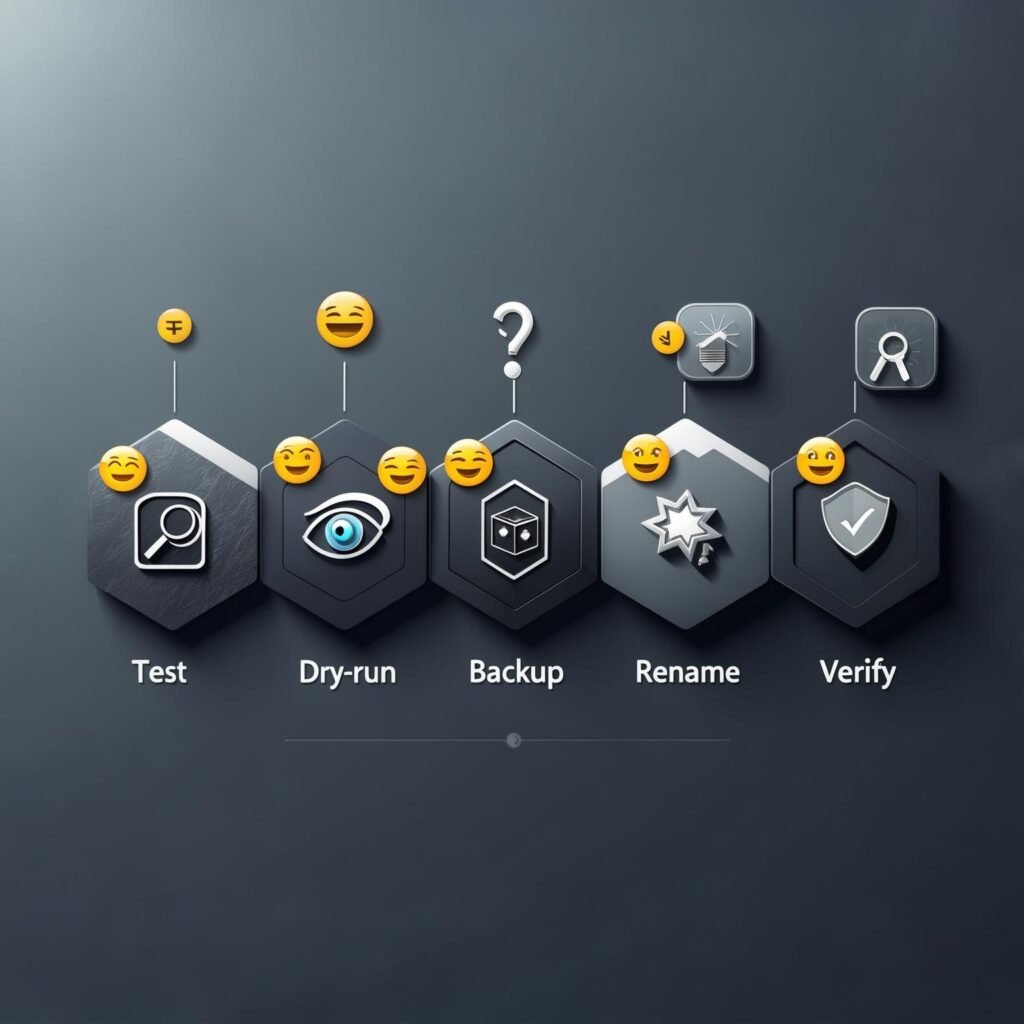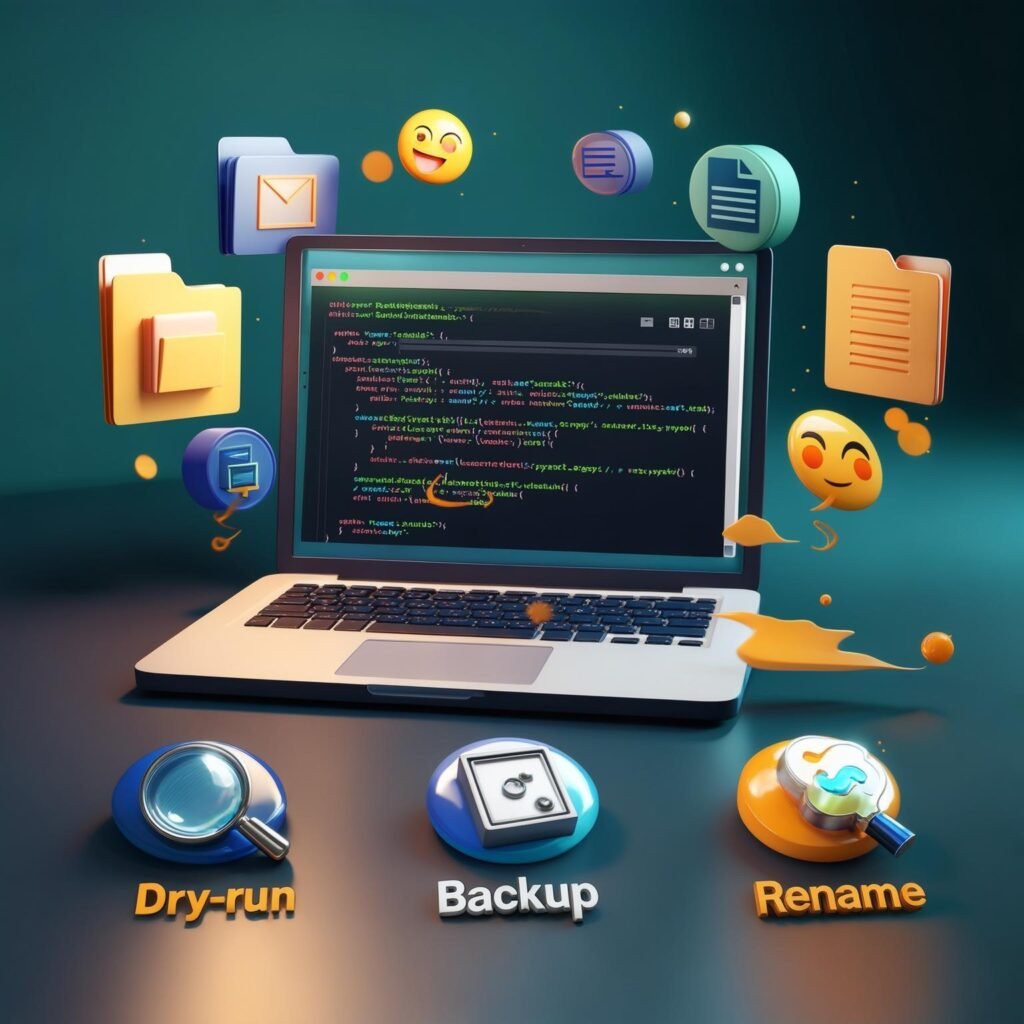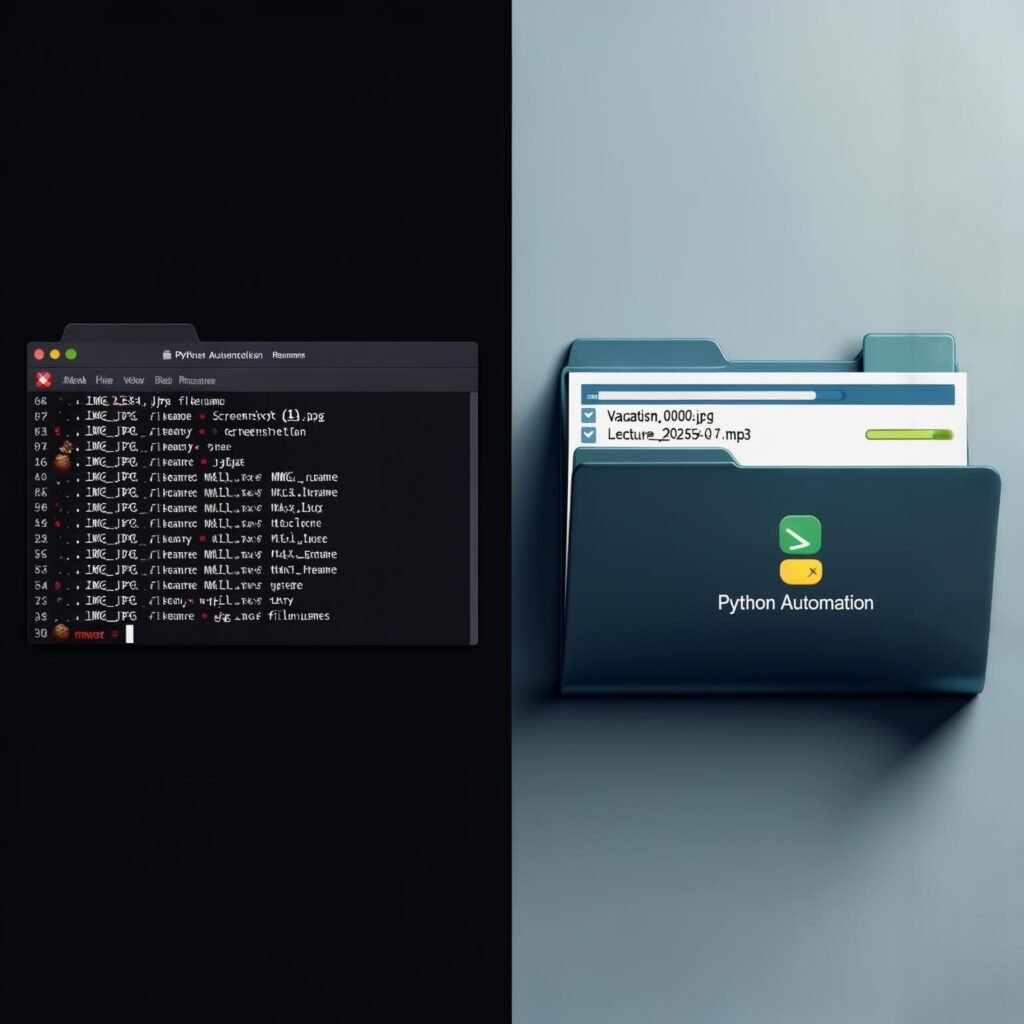Introduction — why file renaming is a perfect automation task
If you’ve ever spent an hour manually renaming hundreds of photos, downloads, or lecture recordings, you know why Python Automation is a superpower. One small script can turn a tedious, error-prone job into a repeatable, safe process. In this article I’ll walk you through real, tested approaches to bulk rename files using Python — from a one-line quick rename to robust scripts with dry-run, logging, and pattern-based renaming.
You don’t need to be a senior dev to automate this. I’ll explain the logic, show practical code, and share tips I learned the hard way (backup first!).

Quick comparison: which approach to choose
| Method | Good for | Pros | Cons |
|---|---|---|---|
os.rename() | Simple renames | Built-in, minimal code | No path objects, less expressive |
pathlib.Path.rename() | Modern scripts | Readable, cross-platform | Same behavior as os for collisions |
shutil.move() | Move + rename (safe) | Can move across filesystems | Slightly heavier |
| Pattern/Regex based script | Complex renames (dates, numbering) | Powerful, flexible | Requires careful testing |
| GUI tools / third-party libs | Non-coders | Visual, fast | Less automatable/scripting-friendly |

1) The minimal example — start here
This tiny script renames files in a directory by adding a prefix. Save it as prefix_rename.py and run from the folder you want to modify.
# prefix_rename.py
from pathlib import Path
p = Path('.') # current folder
for f in p.iterdir():
if f.is_file():
new_name = f"2025_{f.name}"
f.rename(p / new_name)
That’s Python Automation in its simplest form: readable, cross-platform, and effective. But before you run it on important files, add safety features.
2) Best practices (always follow these!)
- Dry-run mode — show changes without writing them.
- Backup / test folder — copy a few files to a test folder first.
- Logging — record what changed and any errors.
- Handle collisions — avoid overwriting by adding numbers.
- Permissions & locks — close files that might be in use.
- Cross-platform paths — use
pathlib, not manual strings.
3) A robust script: dry-run, logging, pattern rename
This example renames files using a regex pattern (e.g., IMG_1234.JPG → Vacation_1234.jpg) and includes dry-run and collision handling.
# bulk_rename.py
import re
from pathlib import Path
import argparse
import logging
from shutil import copy2
logging.basicConfig(filename='bulk_rename.log', level=logging.INFO,
format='%(asctime)s %(levelname)s: %(message)s')
parser = argparse.ArgumentParser(description='Bulk rename files with regex')
parser.add_argument('folder', nargs='?', default='.', help='Target folder')
parser.add_argument('--dry-run', action='store_true', help='Show changes only')
parser.add_argument('--backup', action='store_true', help='Copy originals to backup folder')
args = parser.parse_args()
p = Path(args.folder)
pattern = re.compile(r'IMG_(\d+)\.(jpg|jpeg|png)', re.I)
backup_dir = p / 'backup_originals'
if args.backup:
backup_dir.mkdir(exist_ok=True)
for f in sorted(p.iterdir()):
if not f.is_file():
continue
m = pattern.match(f.name)
if m:
seq, ext = m.groups()
new_name = f"Vacation_{int(seq):04d}.{ext.lower()}"
target = p / new_name
if target.exists():
# avoid overwrite
i = 1
while (p / f"{target.stem}_{i}{target.suffix}").exists():
i += 1
target = p / f"{target.stem}_{i}{target.suffix}"
logging.info(f"{f.name} -> {target.name}")
print(f"{f.name} -> {target.name}")
if not args.dry_run:
if args.backup:
copy2(f, backup_dir / f.name)
f.rename(target)
How to use:python bulk_rename.py ./photos --dry-run --backup
Remove --dry-run when you’re ready.
4) Real-world patterns (useful examples)
Here are a few common renaming patterns and short snippets.
a) Add sequential numbering
for i, f in enumerate(sorted(p.glob('*.mp3')), start=1):
f.rename(p / f"{i:03d}_{f.name}")
b) Change extension to lowercase
for f in p.glob('*.*'):
f.rename(f.with_suffix(f.suffix.lower()))
c) Extract date from filename and prepend (regex)
If your files are like report_20250701_final.pdf:
m = re.search(r'(\d{4})(\d{2})(\d{2})', f.name)
if m:
yyyy, mm, dd = m.groups()
f.rename(p / f"{yyyy}-{mm}-{dd}_{f.name}")
5) Progress & UX: add a progress bar
For large batches, show progress with tqdm:
from tqdm import tqdm
files = list(p.glob('*.*'))
for f in tqdm(files, desc="Renaming files"):
# rename logic here
pass
Install with pip install tqdm.
6) Dealing with edge cases
- Name collisions: always detect
target.exists()and append a suffix like_1,_2. - Files in use: Windows locks files — ensure files are closed.
- Unicode & encodings: filenames may contain non-ASCII characters—
pathlibhandles them in modern Python versions. - Large directories: avoid reading everything into memory when unnecessary; however, listing is typically fine for folders with thousands (but not millions) of files.
7) When to use move vs rename
Path.rename() performs an atomic rename when source and target are on the same filesystem. If you need to move across disks, use shutil.move() which copies + deletes as needed.
8) Automating with scheduling & GUIs
- Cron / Task Scheduler: schedule scripts for nightly runs (e.g., auto-organize downloads).
- Simple GUI: build a minimal Tkinter front-end to let non-technical users select folder and run the script.
- Watchers: use
watchdogto automatically trigger renames when new files appear.
9) Security & privacy considerations
- If files contain private info, do not upload lists to cloud services or third-party analyzers.
- Beware of executing arbitrary filenames as code. Treat all filename content as untrusted input when feeding into other processes.
10) Tools & libraries worth knowing
- pathlib — modern path handling (built-in).
- shutil — for moving/copying files safely.
- watchdog — filesystem event monitoring (
pip install watchdog). - tqdm — progress bars for long jobs.
Using these reduces boilerplate and improves reliability.

Visual aids to include in your post
- A simple flow chart: Test → Dry-run → Backup → Rename → Verify.
- A comparison table (already above) showing
osvspathlibvsshutil. - A code snippet card (the robust script) for copy/paste.
Key insights & practical checklist
- Always run a dry-run first.
- Backup or work on a copy when you’re testing new patterns.
- Use regex for flexible pattern matching, but start with simple patterns.
- Use
pathlibfor cross-platform compatibility and readability. - Log every change — logs are lifesavers when mistakes happen.
Conclusion — why this matters
Python Automation turns repetitive chores into reliable, repeatable workflows. Renaming files in bulk is a small but highly tangible win: minutes saved now become hours over months. With careful dry-runs, backups, and logging, you can automate confidently — and reclaim time for meaningful work.
Call to Action (CTA)
Tried a rename script and hit a snag? Share your filename pattern and a short example in the comments — I’ll help craft a regex or script for your exact case. Download rename_toolkit.zip including the scripts above, a one-click dry-run helper, and a printable checklist.




